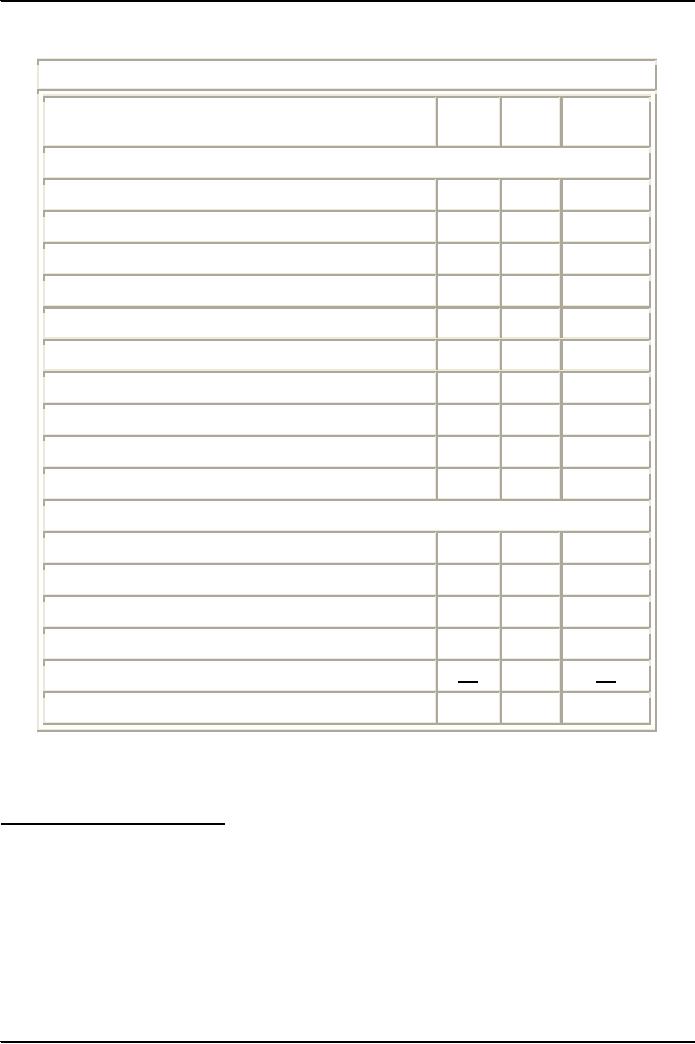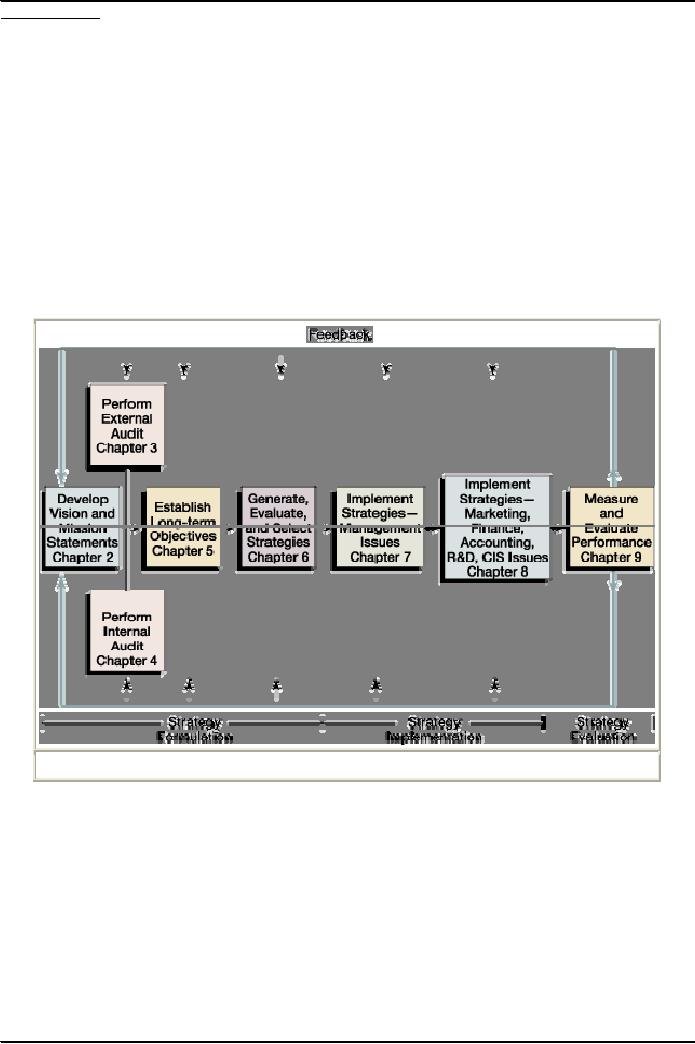 |

Strategic
Management MGT603
VU
Lesson
12
IFE
MATRIX
Objectives:
This
Lecture focuses on identifying and
evaluating a firm's strengths and
weaknesses in the functional
areas
of
business, including management,
marketing, finance/accounting, production/operations,
research and
development,
and computer information systems.
Relationships among these
areas of business are
examined.
Strategic implications of important
functional area concepts are
examined. The process
of
performing
an internal audit is described in
these lectures.
The
Nature of an Internal
Audit
Integrating
Strategy and Culture
Management
Marketing
Finance/Accounting
Production/Operations
Research
and Development
Management
Information Systems
The
Internal Factor Evaluation Matrix
(IFE)
The
Internal Factor Evaluation (IFE)
Matrix
Great
spirits have always encountered
violent opposition from mediocre
minds.
--
Albert
Einstein
A
summary step in conducting an internal
strategic-management audit is to
construct an Internal
Factor
Evaluation
(IFE) Matrix. This
strategy-formulation tool summarizes and
evaluates the major strengths
and
weaknesses
in the functional areas of a business,
and it also provides a basis
for identifying and
evaluating
relationships
among those areas. Intuitive
judgments are required in developing an
IFE Matrix, so the
appearance
of a scientific approach should not be
interpreted to mean this is an
all-powerful technique. A
thorough
understanding of the factors included is more
important than the actual
numbers. Similar to the
EFE
Matrix and Competitive
Profile Matrix, an IFE
Matrix can be developed in five
steps:
1.
List key internal factors as
identified in the internal-audit process.
Use total of from ten to
twenty
internal
factors, including both
strengths and weaknesses.
List strengths first and
then weaknesses.
Be
as specific as possible, using
percentages, ratios, and
comparative numbers.
2.
Assign a weight that ranges
from 0.0 (not important) to
1.0 (all-important) to each
factor. The
weight
assigned to a given factor indicates the
relative importance of the factor to being
successful
in
the firm's industry. Regardless of whether a
key factor is an internal
strength or weakness,
factors
considered
to have the greatest effect on organizational
performance should be assigned the
highest
weights.
The sum of all weights
must equal 1.0.
3.
Assign a 1-to-4 rating to
each factor to indicate whether that
factor represents a major
weakness
(rating
5 1), a minor weakness (rating 5
2), a minor strength (rating 5
3), or a major strength (rating
5
4). Note that strengths
must receive a 4 or 3 rating
and weaknesses must receive
a 1 or 2 rating.
Ratings
are, thus, company based,
whereas the weights in Step 2
are industry based.
4.
Multiply each factor's weight by
its rating to determine a weighted
score for each
variable.
5.
Sum the weighted scores for
each variable to determine the total
weighted score for the
organization.
Regardless
of how many factors are
included in an IFE Matrix, the total
weighted score can range
from a
low
of 1.0 to a high of 4.0,
with the average score being
2.5. Total weighted scores
well below 2.5
characterize
organizations that are weak
internally, whereas scores significantly
above 2.5 indicate a strong
internal
position. Like the EFE
Matrix, an IFE Matrix should include
from 10 to 20 key factors.
The
number
of factors has no effect upon the
range of total weighted scores
because the weights always
sum to
1.0.
When
a key internal factor is
both strength and weakness,
the factor should be included twice in the
IFE
Matrix,
and a weight and rating should be
assigned to each statement.
For example, the Playboy
logo both
helps
and hurts Playboy Enterprises; the
logo attracts customers to the
Playboy
magazine,
but it keeps the
Playboy
cable channel out of many
markets.
An
example of an IFE Matrix for
Circus Circus Enterprises is
provided in Table. Note that
the firm's major
strengths
are its size, occupancy
rates, property, and
long-range planning as indicated by the
rating of 4. The
47

Strategic
Management MGT603
VU
major
weaknesses are locations and
recent joint venture. The
total weighted score of 2.75
indicates that the
firm
is above average in its
overall internal
strength.
A
Sample Internal Factor Evaluation Matrix
for Circus Circus
Enterprises
Weighted
Key
Internal Factors
Weight
Rating
Score
Internal
Strengths
1.
Largest casino company in the
United States
.05
4
.20
2.
Room occupancy rates over 95% in
Las Vegas
.10
4
.40
3.
Increasing free cash
flows
.05
3
.15
4.
Owns one mile on Las Vegas
Strip
.15
4
.60
5.
Strong management
team
.05
3
.15
6.
Buffets at most facilities
.05
3
.15
7.
Minimal comps
provided
.05
3
.15
8.
Long-range planning
.05
4
.20
9.
Reputation as family-friendly
.05
3
.15
10.
Financial ratios
.05
3
.15
Internal
Weaknesses
1.
Most properties are located in
Las Vegas
.05
1
.05
2.
Little diversification
.05
2
.10
3.
Family reputation, not high
rollers
.05
2
.10
4.
Laughlin properties
.10
1
.10
5.
Recent loss of joint
ventures
.10
1
.10
TOTAL
1.00
2.75
In
multidivisional firms, each autonomous
division or strategic business
unit should construct an
IFE
Matrix.
Divisional matrices then can
be integrated to develop an overall corporate IFE
Matrix.
The
Nature of an Internal
Audit
Basis
for objectives &
strategies:
Internal
strengths/weaknesses
External
opportunities/threats
Clear
statement of mission
Functional
business areas:
Vary
by organization
Divisions
have differing strengths and
weaknesses
Distinctive
Competencies:
A
firm's strengths that cannot be
easily matched or imitated by
competitors
Building
competitive advantage involves
taking advantage of distinctive
competencies
Strategies
designed in part to improve on a
firm's weaknesses and turn
to strengths
48

Strategic
Management MGT603
VU
Internal
Audit is
Parallels process of external audit. It
gathers & assimilates information
from:
o
Management
o
Marketing
o
Finance/accounting
o
Production/operations
o
Research
& development
o
Management
information systems
Involvement
in performing an internal
strategic-management audit provides
vehicle for understanding
nature and effect of
decisions
in other functional business areas of the
firm.
All
organizations have strengths
and weaknesses in the functional
areas of business. No enterprise is
equally
strong
or weak in all areas. Maytag,
for example, is known for
excellent production and
product design,
whereas
Procter & Gamble is known for
superb marketing. Internal
strengths/weaknesses, coupled with
external
opportunities/threats and a clear
statement of mission, provide the
basis for establishing
objectives
and
strategies. Objectives and
strategies are established
with the intention of capitalizing upon
internal
strengths
and overcoming weaknesses. The
internal-audit part of the
strategic-management process is
illustrated
in Figure below.
A
Comprehensive Strategic-Management
Model
Key
to organizational success: Internal
audit creates an environment of
Coordination and understanding
among
managers from all functional
areas.
Key
Internal Forces
It
is not possible in a business
policy text to review in depth
all the material presented in
courses such as
marketing,
finance, accounting, management, computer
information systems, and
production/operations;
there
are many sub areas
within these functions, such as
customer service, warranties,
advertising,
packaging,
and pricing under marketing.
For
different types of organizations,
such as hospitals, universities,
and government agencies, the
functional
business
areas, of course, differ. In a hospital,
for example, functional
areas may include cardiology,
hematology,
nursing, maintenance, physician support,
and receivables. Functional
areas of a university can
include
athletic programs, placement services,
housing, fund raising,
academic research, counseling,
and
49

Strategic
Management MGT603
VU
intramural
programs. Within large
organizations, each division
has certain strengths and
weaknesses. For
example,
AT&T is strong in communications and
weak in computers.
A
firm's strengths that cannot be easily
matched or imitated by competitors are
called distinctive
competencies.
Building
competitive advantages involves
taking advantage of distinctive
competencies. For example,
3M
exploits
its distinctive competence in
research and development by producing a
wide range of innovative
products.
Strategies are designed in
part to improve on a firm's weaknesses,
turning them into
strengths,
and
maybe even into distinctive
competencies.
Some
researchers emphasize the importance of the
internal audit part of the
strategic-management process
by
comparing it to the external audit.
The
Process of Performing an Internal
Audit
Functional
relationships refer to the
Number and complexity
increases relative to organization
size.
The
process of performing an internal
audit closely
parallels the process of performing an
external audit.
Representative
Managers and employees from
throughout the firm need to be
involved in determining a
firm's
strengths and weaknesses.
The internal audit requires
gathering and assimilating information
about
the
firm's management, marketing, finance/accounting,
production/operations, research and
development
(R&D),
and computer information systems
operations.
Compared
to the external audit, the process of performing an
internal audit provides more
opportunity for
participants
to understand how their
jobs, departments, and divisions
fit into the whole organization. This
is
a
great benefit because
managers and employees
perform better when they understand how
their work
affects
other areas and activities of the
firm. For example, when
marketing and manufacturing
managers
jointly
discuss issues related to
internal strengths and
weaknesses, they gain a better appreciation of
issues,
problems,
concerns, and needs in all
the functional areas. In organizations
that do not use
strategic
management,
marketing, finance, and manufacturing
managers often do not interact
with each other in
significant
ways. Performing an internal audit,
thus, is an excellent vehicle or
forum for improving
the
process
of communication in the organization. Communication
may be
the most important word
in
management.
Performing
an internal audit requires
gathering, assimilating, and evaluating
information about the firm's
operations.
Critical success factors, consisting of
both strengths and
weaknesses, can be identified
and
prioritized
in the manner discussed later
chapters.
The
development of conclusions on the 10 to 20 most
important organizational strengths and
weaknesses
can
be, as any experienced
manager knows, a difficult
task, when it involves managers
representing various
organizational
interests and points of
view. Developing a 20-page
list of strengths and
weaknesses could be
accomplished
relatively easily, but a list of the 10
to 15 most important ones
involves significant analysis
and
negotiation.
This is true because of the judgments
that are required and the
impact which such a list
will
inevitably
have as it is used in the formulation,
implementation, and evaluation of
strategies.
Strategic
management is a highly interactive
process that requires effective
coordination among
management,
marketing, finance/accounting, production/operations,
R&D, and computer information
systems
managers. Although the
strategic-management process is overseen
by strategists, success
requires
that
managers and employees from
all functional areas work
together to provide ideas and
information.
Financial
managers, for example, may
need to restrict the number of feasible
options available to operations
managers,
or R&D managers may develop such
good products that marketing managers
need to set higher
objectives.
A key to organizational success is effective
coordination and understanding
among managers
from
all functional business
areas. Through involvement in
performing an internal
strategic-management
audit,
managers from different
departments and divisions of the firm
come to understand the nature
and
effect
of decisions in other functional
business areas in their
firm. Knowledge of these relationships
is
critical
for effectively establishing
objectives and
strategies.
A
failure to recognize and
understand relationships among the
functional areas of business
can be
detrimental
to strategic management, and the number
of those relationships that
must be managed
increases
dramatically
with a firm's size, diversity,
geographic dispersion, and the number of
products or services
offered.
Governmental and nonprofit
enterprises traditionally have
not placed sufficient
emphasis on
relationships
among the business functions. For
example, some state
governments, utilities, universities,
and
hospitals
only recently have begun to
establish marketing objectives and
policies that are consistent
with
their
financial capabilities and
limitations. Some firms place
too great an emphasis on one
function at the
expense
of others.
50

Strategic
Management MGT603
VU
Financial
Ratio Analysis:
Financial
ratio analysis exemplifies
the complexity of relationships among the
functional areas of business.
A
declining
return on investment or profit margin
ratio could be the result of ineffective
marketing, poor
management
policies, research and development
errors, or a weak computer information
system. The
effectiveness
of strategy formulation, implementation,
and evaluation activities hinges upon a
clear
understanding
of how major business functions affect
one another. For strategies
to succeed, a coordinated
effort
among all the functional
areas of business is
needed.
Integrating
Strategy and Culture
Organizational
Culture
Pattern
of behavior developed by an organization as it
learns to cope with its
problem of external adaptation
and internal
integration...is
considered valid and taught
to new members
Resistant
to change
May
represent a strength or weakness of the
firm
Relationships
among a firm's functional business
activities perhaps can be exemplified
best by focusing on
organizational
culture, an internal phenomenon that
permeates all departments
and divisions of an
organization.
Organizational
culture can be defined as "a
pattern of behavior developed by
an
organization
as it learns to cope with
its problem of external
adaptation and internal
integration
that
has worked well enough to be
considered valid and to be
taught to new members as
the
correct
way to perceive, think, and
feel." This
definition emphasizes the importance of
matching
external
with internal factors in making
strategic decisions.
Organizational
culture captures the subtle, elusive,
and largely unconscious
forces that shape a
workplace.
Remarkably
resistant to change, culture can
represent a major strength or weakness
for the firm. It can
be
an
underlying reason for
strengths or weaknesses in any of the
major business functions.
Defined
in Table below cultural
products include
values, beliefs, rites,
rituals, ceremonies, myths,
stories,
legends,
sagas, language, metaphors,
symbols, heroes, and
heroines. These products or dimensions
are
levers
that strategists can use to
influence and direct strategy
formulation, implementation, and
evaluation
activities.
An organization's culture compares to an
individual's personality in the sense
that no organization
has
the same culture and no individual
has the same personality. Both culture
and personality are
fairly
enduring
and can be warm, aggressive,
friendly, open, innovative, conservative,
liberal, harsh, or likable.
Cultural
Products and Associated
Definitions
Rites
Relatively
elaborate, dramatic, planned sets of
activities that
consolidate
various forms of cultural expressions
into one event,
carried
out through social interactions,
usually for the benefit
of
an
audience
Ceremonial
A
system of several rites
connected with a single
occasion or event
Ritual
A
standardized, detailed set of techniques
and behaviors that
manage
anxieties, but seldom produce intended,
technical
consequences
of practical importance
Myth
A
dramatic narrative of imagined events
usually used to
explain
origins
or transformations of something. Also, an
unquestioned
belief
about the practical benefits of certain
techniques and
behaviors
that is not supported by
facts
Saga
An
historical narrative describing the unique
accomplishments of
a
group and its leaders,
usually in heroic terms
Legend
A
handed-down narrative of some wonderful event
that is based
on
history but has been
embellished with fictional
details
Story
A
narrative based on true events, sometimes
a combination of
truth
and fiction
51

Strategic
Management MGT603
VU
Folktale
A
completely fictional narrative
Symbol
Any
object, act, event, quality, or
relation that serves as a
vehicle
for
conveying meaning, usually by
representing another thing
Language
A
particular form or manner in which
members of a group
use
sounds
and written signs to convey
meanings to each
other
Metaphors
Shorthand
words used to capture a
vision or to reinforce old or
new
values
Values
Life-directing
attitudes that serve as behavioral
guidelines
Belief
An
understanding of a particular phenomenon
Heroes/Heroines
Individuals
whom the organization has legitimized to
model
behavior
for others
Source:
Adapted
from H.M. Trice and
J.M. Beyer, "Studying Organizational
Cultures through
Rites
and Ceremonials," Academy
of Management Review 9, no.
4 (October 1984): 655.
Dimensions
of organizational culture permeate all the
functional areas of business. It is
something of an
art
to uncover the basic values and
beliefs that are buried
deeply in an organization's rich
collection of
stories,
language, heroes, and
rituals, but cultural products
can represent important
strengths and
weaknesses.
Culture is an aspect of organizations
that no longer can be taken
for granted in performing
an
internal
strategic-management audit because
culture and strategy must
work together.
Culture
can inhibit strategic
management:
Miss
changes in external environment because
they are blinded by strongly held
beliefs
When
a culture has been effective in the past,
natural tendency to stick with it in
future, even
during
times of major strategic
change
The
strategic-management process takes
place largely within a particular
organization's culture. An
organization's
culture must support the collective commitment of
its people to a common purpose. It
must
foster
competence and enthusiasm
among managers and
employees.
Organizational
culture significantly affects business
decisions and, thus, must be
evaluated during an
internal
strategic-management audit. If strategies
can capitalize on cultural strengths,
such as a strong work
ethic
or highly ethical beliefs,
then management often can
implement changes swiftly and
easily. However, if
the
firm's culture is not supportive, strategic
changes may be ineffective or
even counterproductive. A firm's
culture
can become antagonistic to
new strategies, with the
result being confusion and
disorientation. An
organization's
culture should infuse individuals with
enthusiasm for implementing
strategies.
Internal
strengths and weaknesses
associated with a firm's culture
sometimes are overlooked
because of the
inter
functional nature of this phenomenon. It is
important, therefore, for strategists to
understand their
firm
as a socio cultural system. Success is
often determined by linkages between a
firm's culture and
strategies.
The challenge of strategic
management today is to bring about the
changes in organizational
culture
and individual mind-sets
necessary to support the formulation,
implementation, and evaluation of
strategies.
Management
The
functions
of management consist
of five basic activities:
planning, organizing, motivating, staffing,
and
controlling.
An overview of these activities is
provided in Table.
The
Basic Functions of Management
Stage
of Strategic-
Management
Process
When Most
Function
Description
Important
52

Strategic
Management MGT603
VU
Planning
Planning
consists of all those
managerial activities Strategy
Formulation
related
to preparing for the future. Specific
tasks
include
forecasting, establishing objectives,
devising
strategies,
developing policies, and
setting goals.
Organizing
Organizing
includes all those
managerial activities that
Strategy
result
in a structure of task and
authority relationships.
Implementation
Specific
areas include organizational design,
job
specialization,
job descriptions, job
specifications,
span
of the control, unity of command,
coordination,
job
design, and job
analysis.
Motivating
Motivating
involves efforts directed
toward shaping
Strategy
human
behavior. Specific topics include
leadership, Implementation
communication,
work groups, behavior
modification,
delegation
of authority, job enrichment,
job
satisfaction,
needs fulfillment, organizational
change,
employee
morale, and managerial
morale.
Staffing
Staffing
activities are centered on personnel or
human Strategy
resource
management. Included are
wage and salary
Implementation
administration,
employee benefits,
interviewing,
hiring,
firing, training, management
development,
employee
safety, affirmative action, equal
employment
opportunity,
union relations, career
development,
personnel
research, discipline policies,
grievance
procedures,
and public relations.
Controlling
Controlling
refers to all those
managerial activities Strategy
Evaluation
directed
toward ensuring that actual
results are
consistent
with planned results. Key
areas of concern
include
quality control, financial
control, sales
control,
inventory
control, and expense
control, analysis of
variances,
rewards, and
sanctions.
53
Table of Contents:
- NATURE OF STRATEGIC MANAGEMENT:Interpretation, Strategy evaluation
- KEY TERMS IN STRATEGIC MANAGEMENT:Adapting to change, Mission Statements
- INTERNAL FACTORS & LONG TERM GOALS:Strategies, Annual Objectives
- BENEFITS OF STRATEGIC MANAGEMENT:Non- financial Benefits, Nature of global competition
- COMPREHENSIVE STRATEGIC MODEL:Mission statement, Narrow Mission:
- CHARACTERISTICS OF A MISSION STATEMENT:A Declaration of Attitude
- EXTERNAL ASSESSMENT:The Nature of an External Audit, Economic Forces
- KEY EXTERNAL FACTORS:Economic Forces, Trends for the 2000ís USA
- EXTERNAL ASSESSMENT (KEY EXTERNAL FACTORS):Political, Governmental, and Legal Forces
- TECHNOLOGICAL FORCES:Technology-based issues
- INDUSTRY ANALYSIS:Global challenge, The Competitive Profile Matrix (CPM)
- IFE MATRIX:The Internal Factor Evaluation (IFE) Matrix, Internal Audit
- FUNCTIONS OF MANAGEMENT:Planning, Organizing, Motivating, Staffing
- FUNCTIONS OF MANAGEMENT:Customer Analysis, Product and Service Planning, Pricing
- INTERNAL ASSESSMENT (FINANCE/ACCOUNTING):Basic Types of Financial Ratios
- ANALYTICAL TOOLS:Research and Development, The functional support role
- THE INTERNAL FACTOR EVALUATION (IFE) MATRIX:Explanation
- TYPES OF STRATEGIES:The Nature of Long-Term Objectives, Integration Strategies
- TYPES OF STRATEGIES:Horizontal Integration, Michael Porterís Generic Strategies
- TYPES OF STRATEGIES:Intensive Strategies, Market Development, Product Development
- TYPES OF STRATEGIES:Diversification Strategies, Conglomerate Diversification
- TYPES OF STRATEGIES:Guidelines for Divestiture, Guidelines for Liquidation
- STRATEGY-FORMULATION FRAMEWORK:A Comprehensive Strategy-Formulation Framework
- THREATS-OPPORTUNITIES-WEAKNESSES-STRENGTHS (TOWS) MATRIX:WT Strategies
- THE STRATEGIC POSITION AND ACTION EVALUATION (SPACE) MATRIX
- THE STRATEGIC POSITION AND ACTION EVALUATION (SPACE) MATRIX
- BOSTON CONSULTING GROUP (BCG) MATRIX:Cash cows, Question marks
- BOSTON CONSULTING GROUP (BCG) MATRIX:Steps for the development of IE matrix
- GRAND STRATEGY MATRIX:RAPID MARKET GROWTH, SLOW MARKET GROWTH
- GRAND STRATEGY MATRIX:Preparation of matrix, Key External Factors
- THE NATURE OF STRATEGY IMPLEMENTATION:Management Perspectives, The SMART criteria
- RESOURCE ALLOCATION
- ORGANIZATIONAL STRUCTURE:Divisional Structure, The Matrix Structure
- RESTRUCTURING:Characteristics, Results, Reengineering
- PRODUCTION/OPERATIONS CONCERNS WHEN IMPLEMENTING STRATEGIES:Philosophy
- MARKET SEGMENTATION:Demographic Segmentation, Behavioralistic Segmentation
- MARKET SEGMENTATION:Product Decisions, Distribution (Place) Decisions, Product Positioning
- FINANCE/ACCOUNTING ISSUES:DEBIT, USES OF PRO FORMA STATEMENTS
- RESEARCH AND DEVELOPMENT ISSUES
- STRATEGY REVIEW, EVALUATION AND CONTROL:Evaluation, The threat of new entrants
- PORTER SUPPLY CHAIN MODEL:The activities of the Value Chain, Support activities
- STRATEGY EVALUATION:Consistency, The process of evaluating Strategies
- REVIEWING BASES OF STRATEGY:Measuring Organizational Performance
- MEASURING ORGANIZATIONAL PERFORMANCE
- CHARACTERISTICS OF AN EFFECTIVE EVALUATION SYSTEM:Contingency Planning